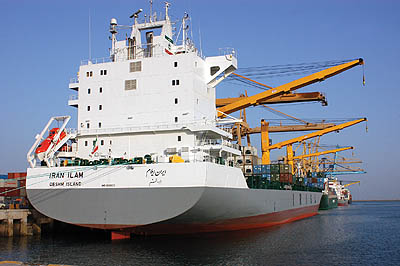صنعت کشتیرانی در ایران- سه ماهه دوم 2015
BMI Industry View
The outlook for the Iranian shipping sector is brighter than it has been in recent years, and we forecast a second consecutive year of growth at the primary container port of Bandar Abbas in 2015. The ongoing easing of sanctions - not least on the port operator itself - will boost throughput. However, we note increased risk to our projections since our last quarterly update, as plummeting oil prices will weigh on Iranian economic activity and port throughputs.

Our outlook for the Iranian shipping sector depends on the current rapprochement between the pariah state and the West, and the attendant relaxation of sanctions, continuing. The Iranian economy will expand slowly in 2015 as talks on the nuclear programme continue without reaching a breakthrough, and BMI projects real GDP growth of 2.8% in 2015, following our estimate of a 2.9% contraction in 2013 and 2.8% growth in 2014. The shipping sector will be a major beneficiary of an easing of sanctions, not only through a general recovery in the economy, but also from a fundamental perspective. The removal of port operator Tidewater from EU sanction lists means that international shipping companies are set to begin calling at Iranian ports such as Bandar Abbas once more. Growth will take time to recover, however, given the massive inflation seen in Iran in recent years, and the damage done to consumers' purchasing power as a result.
Headline Industry Data
■ 2015 port of Bandar Abbas throughput forecast to grow by 6.7%, and average growth of 6.8% to 2019.
■ 2019 port of Bandar Abbas throughput expected to reach 2.19mn twenty-foot equivalent units (TEUs) - still insufficient to match 2011 volumes.
■ 2015 total real trade is forecast to return to contract by 0.4% as oil prices fall.
Key Industry Trends
Trade With India To Be Boosted By New Port: The development of the new Chabahar port in Iran is continuing apace. The facility is being constructed with an eye to increasing trade between Iran and India.
In the latest development has been the announcement that India and Iran are to set up a direct shipping line between Iran's Chabahar and India's Mumbai Ports, according to the Chairman of the Iranian Chamber of Commerce Gholam Hossein Shafeyee. 'This is the best, the shortest and the most economical route for the export of Indian commodities to Central Asia, the Caucasus and Europe,' said Shafeyee.
Bulking Up Ports' Capacity: Iran plans to expand the capacity of its ports by 210mn tonnes, according to the Port and Maritime Organization's Managing Director Mohammad Saeednejad. The northern and southern ports have a reloading and loading capacity of 185mn tonnes, though more than 140mn tonnes of imports, exports, transit and tranship are currently handled at the ports. Saeednejad stated that during the first seven months of 2014, the ports reported an increase of 9% y-o-y in loading and reloading, which was expected to continue to end-2014. Saeednejad also mentioned the improved handling capacity at Bandar Abbas, which is expected to increase to 8.5mn containers annually through investment and development programmes. However, we believe that the port is currently handling less than 2mn TEUs per annum, and that it will be some time before it reaches such volumes.
EU Loses Court Battle: Things are looking up for Iranian shipping companies, in particular IRISL and the numerous subsidiaries set up by the company, as the EU High Court ruled in January 2015 that sanctions against it were not justified and that there was no evidence that the bodies were abetting the Iranian government's alleged nuclear weapons development programme. We expect that the company will ramp up its operations in the wake of this ruling.
Key Risks To Outlook
There are serious risks to all our forecasts for Iranian shipping, just as there are to our macroeconomic outlook for the country. Should the current rapprochement between Iran with the West and the US continue, there is serious upside risk to our outlook as sanctions continue to be removed. The lifting of sanctions on shipping insurance, for example, has already resulted in an increase in oil exports, and the Q314 removal of sanctions against port operator Tidewater will see container volumes at Bandar Abbas grow once more.
Equally, it should be noted that if negotiations stumble, the end position could be worse than it currently is if even harsher restrictions on Iranian trade are imposed. This would generate downside risk to our forecasts.
The fall in the oil price at the close of 2014 also presents risk to our forecasts, as it will impede economic activity in Iran.
گزارش تحلیلی بیزینس مانیتور- صنعت کشتیرانی در ایران- سه ماهه دوم 2015

